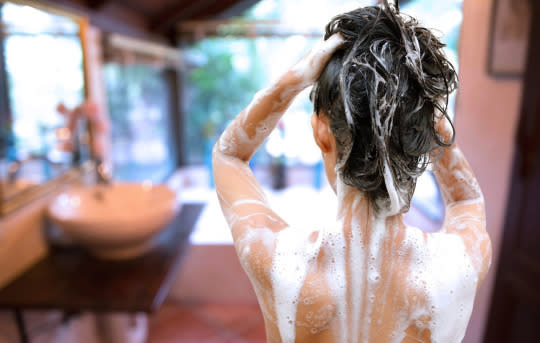Do You Really Need to Switch Shampoos for Healthier-Looking Hair?

Don’t trash your favorite product just yet. (Photo: Shutterstock)
You’ve heard it before: It’s important to switch up your hair products every so often to achieve that continuous volume and shine. So when you catch a glimpse of yourself in the mirror and notice you’re sporting limp, greasy locks when you washed your hair less than 24 hours ago, you start to think: Could it be true? Has my shampoo soul mate let me down after all this time?
Don’t turn your back on your bottled bestie too fast, say experts. “It’s a myth that hair gets immune to shampoo,” says Shannel Mariano, of latest-hairstyles.com. “When you’re experiencing buildup or dryness, it’s usually because you’re using the wrong shampoo for your hair at that time—not because the formula all of a sudden stops working for you.”
Find the Root Cause of Your Limp Strands
Before you toss your go-to shampoo in the wastebasket, consider what really is to blame. Everyone’s hair is different—and using the wrong shampoo for your hair type could cause things to go haywire. If you’re a curly girl, you should reach for a shampoo that helps with curl retention, while those with dry or damaged strands should stick with one that heavily moisturizes, fore example, says Paul Labrecque, hairstylist and owner of Paul Labrecque Salon and Spa in New York City.
But it’s not just your hair quality and type that can be the determining factor for less-than-stellar strands. “Your hair could alter its response to products due to seasonal changes, a change in the water, swimming in chlorine, or even a change in hormone levels,” says Caroline Muller, hairstylist and makeup artist at Studio B Salon in Rhode Island.
That means you may need a more moisturizing shampoo in the winter, a damage remedy shampoo after getting balayage highlights, or a volumizing shampoo if you experience temporary hair loss after a pregnancy, explains Mariano.
Please: Don’t Over-Wash Your Hair!
If you’re an exercise fiend, you’re probably tempted to hop in the shower the second you walk in the door. But doing so can actually have the opposite effect than desired—leaving your hair limp and lifeless. “Remember that sweat is water and not dirt—oil is dirt,” says Labrecque. “Instead, use a dry shampoo, which leaves a powder-like film that absorbs oil and extends hair lift without cleansing the scalp.”
Another quick volumizing trick is to shampoo just your roots, while focusing conditioner from the middle of your strands to the ends strands. “This will allow your root area to wake back up and have more lift, and also enhance the shine of the middle and ends of your hair,” says Paul Norton, Joico celebrity hairstylist.
Swap in a Clarifying Shampoo Twice a Month
“Your hair has a personality not unlike your own,” says Norton. “Imagine you start out on a Monday with clean, healthy, shiny hair, skip two days of washing but use plenty of product like dry shampoo as well as heated tools. By the time Sunday rolls around, you certainly need to press the refresh button.”
Enter clarifying shampoo. These deep cleansers can get you out of your hair funk by removing buildup that’s developed over time. “It’s beneficial for frequent gym-goers who may not wash their hair every time they work out—the clarifying shampoo provides that extra cleanse they may need from second-day build-up,” says Muller.
Just remember to go easy if you have color-treated hair. “A clarifying shampoo may cause your color to fade even faster, so try not to use it more than once a week at most to give your hair and scalp a good and thorough wash without drying it out too much,” says Muller.
There’s lots of factors at play when it comes to how well your hair-cleansing products work, but one thing’s for certain: You can’t get immune to your shampoo. So while the right ‘poo today may not be the right ‘poo tomorrow, that doesn’t mean it’s not the right 'poo in general.
More from Women’s Health:
The Best Deep Conditioner for Every Hair Type
5 Ways to Cure Your Itchy, Flaky Winter Scalp
6 Possible Reasons Why Your Hair Texture or Color Changed on Its Own
By Jenn Sinrich
